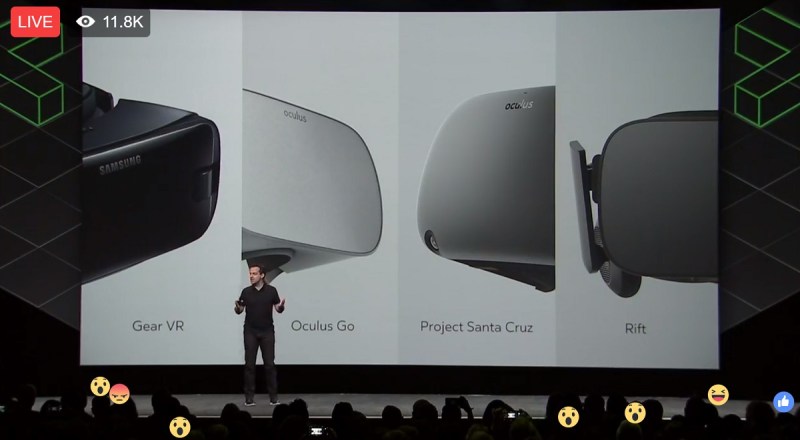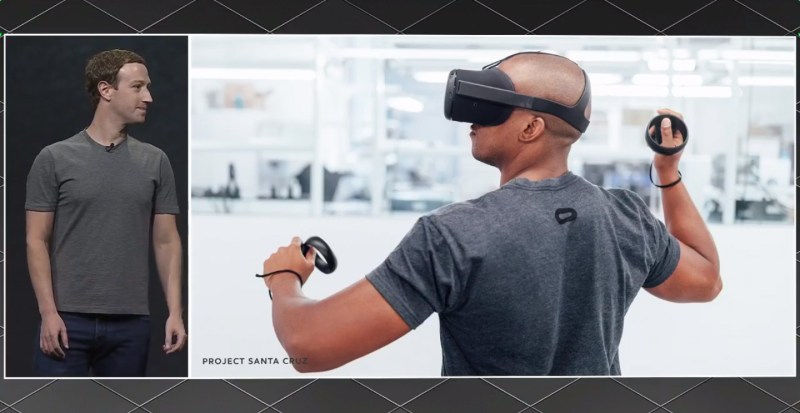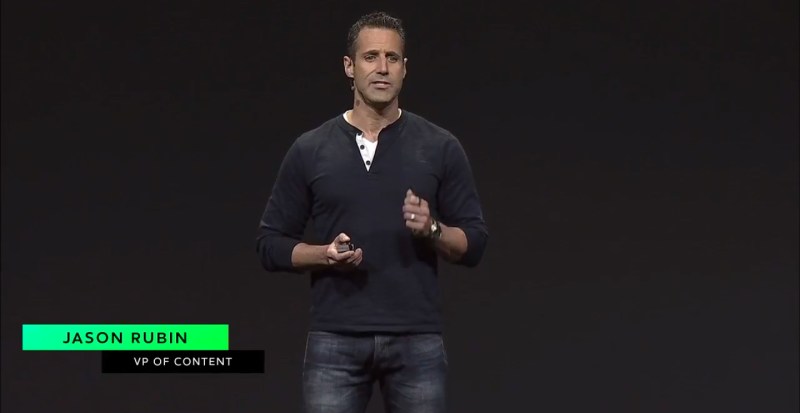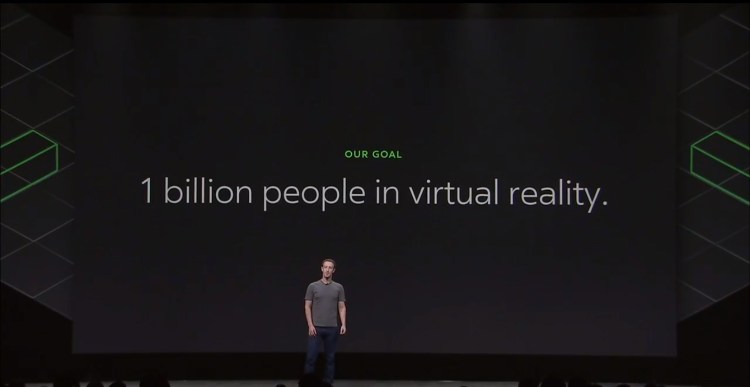Mark Zuckerberg, CEO of Facebook, injected a dose of optimism into the crowd at the Oculus Connect event this week at the San Jose Convention Center when he set a goal of getting a billion people into virtual reality. That’s reassuring in a way, since the Oculus Rift, the Samsung Gear VR, and other virtual reality products haven’t set the world on fire since launching in the spring of 2016.
Zuckerberg unveiled a $200 wireless Oculus Go headset, and showed that his company was doubling down on Oculus, which Facebook acquired for billions of dollars in 2014. A year ago, Zuckerberg said that Facebook had invested $250 million in VR applications and would invest $250 milion more in the future. This year, some developers said they had hoped that Facebook would open the spigot even more and invest more money in VR apps. Zuckerberg didn’t do that, but he certainly showed that his company continues to invest in VR, with new hardware prototypes such as Project Santa Cruz, a wireless standalone VR headset with more accurate tracking. I tried out Santa Cruz, and it was a really liberating experience of untethered VR in a virtual world without compromises.

Above: Facebook’s Oculus virtual reality products.
But I detected some despair as well. A game developer who was looking for work felt like VR was in a state of crisis. It was in the middle of the trough of disillusionment. VR sales aren’t what they used to be. Some companies have gone out of business — Social VR pioneer AltSpaceVR had to be rescued by Microsoft. Market researchers have lowered their forecasts.
At the same time, the small market is fragmenting. Microsoft has moved into the market and declared that mixed reality — a combination of VR and augmented reality — is the future. Facebook has four different products on the market, ranging from the Samsung Gear VR for $100, to the PC-based Oculus Rift for $400. Competition is good, but developers haven’t really figured out which platform is going to win. The platform makers haven’t truly defined the complete set of features that should be in VR. Which features — wireless, 10-finger tracking, haptics feedback, or simply a low price — will lead to mass adoption?

Above: Santa Cruz prototype at Oculus Connect 4.
The Consumer Technology Association, a big trade association, estimated this week that 2.7 million VR headsets would be sold in the fourth quarter in the U.S. That’s up 283 percent, a big leap upward. But that’s not many units, considering they’re going to be divided among so many VR platforms, including Oculus, Sony, HTC, Samsung, and Microsoft and its allies.
Many developers are shifting their efforts to augmented reality, as Apple and Google have launched smartphone-based platforms on that front. Others are seeking new rounds of money, but they may be discovering that the venture funding isn’t as plentiful as it once was. VR startups like Playful are pivoting and repurposing their VR games like Lucky’s Tale as 2D screen console games. That keeps money coming in the door. And in gaming, esports investments seem to be a lot hotter than VR investments.
Jason Rubin, head of studios at Oculus, acknowledged the challenges that VR faces. But he pointed to Santa Cruz. And he welcomed the arrival of Respawn Entertainment, maker of the Titanfall console and PC games, as the newest Triple-A game developer making games for VR. Respawn’s effort is a big one, and it is set to arrive in 2019.

Above: Oculus video of wireless vr headset.
“I love all developers. But there is this feeling that a certain scale of developer isn’t in the business,” said Rubin, in an interview with GamesBeat. “Generally speaking, that’s because the biggest developers and publishers have billion-dollar franchises that they’re constantly laid on trying to get out. You know how the business works. It’s not lack of interest. We’ve been talking to Respawn for a long time. The interest has always been there. They just needed the opportunity.”
Rubin’s optimism stems from the notion that almost every major game publisher has tried out VR or is about to do something.
I asked Rubin about Playful turning to a 2D game, even as it creates more VR titles. He responded, “Developers will go back and forth. In some ways it’s like TV and film for a director. It’s different media different restrictions and relationships, but they’re both interesting. It’s quite possible that it will continue that way even if VR becomes a very large market. We come out of the trough and see everything we’re predicting, but there’s still a world where 2D games make a lot of sense for a lot of people.”
I noted that Intel’s approach of using WiGig wireless networking from the VR headset to the PC would add yet another option for hardware makers. But Rubin said that the industry should be careful about investing in hardware that will add some benefit but will hurt overall because it could add too much cost.

Above: Jason Rubin at Oculus Connect 4
John Carmack, chief technology officer at Oculus, has been working on VR for four years. I thought he put it well when he summed up the VR market in his keynote speech at Oculus Connect on Thursday. He was encouraged by the explosion of 360-degree VR videos and photos.
“VR hasn’t taken over the world yet, but it is showing up in a lot of surprising places,” said Carmack. “Just last week, I was at the grocery store. And there was a poster for a Gear VR for some immersive wine-tasting experience. There is a stage where we are out of the heroic age of VR. We are shipping. People signed up for this bold new journey. Some people thought it would be magic right off the bat. It would go out like a bolt of lightning. There would be this huge amount of success. The truth is we are a product competing against hundreds of other very good products. It’s going to take a whole lot of work to reach that level of success. I’m optimistic in so many ways. Much of what makes me optimistic is that it actually feels like all of the ingredients we need are already really here. They are just not stirred, cooked, and seasoned exactly how they need to be.”
There are 2,000 applications in the Oculus Store. That’s a good number. But there isn’t much revenue to spread among those apps yet.
Above: Oculus avatars
Facebook Spaces gave me the most optimism. I did a demo of the social VR app, which let me enter the same virtual space with a guy named Phil, who showed me the ropes. We visited a 360-degree photo of the Eiffel Tower. We saw the 360-degree view of the Echo Arena tournament upstairs. And we did some virtual fishing in an ice hole together courtesy of Tommy Palm’s Resolution Games. I went into a live broadcast on Facebook Live. It was all seamless, accessible, and easy to do.
On the other hand, I still worry about the openness of VR at Facebook. Zuckerberg and his colleagues didn’t say much about opening up the platform and synchronizing on hardware or software standards across the industry to make life easier for developers. The most they offered was that Oculus avatars would be able to go cross-platform, so you could create an avatar, or virtual character, on the Oculus Rift and take that character to your SteamVR or Google Daydream apps.
But someone cynically pointed out that those avatars would yield a bumper crop of data on how much usage was happening on those rival platforms. In other words, going cross-platform is a lot like Facebook Connect, allowing Facebook to gain access to more of the world’s data. I firmly believe in the Metaverse, and that VR will be key to making it happen. But I share the concern of Tim Sweeney, CEO of Epic Games, who worries that a single company will try to own it all.
Right now, there isn’t much for any one company to own when it comes to the VR market. But it’s always good to be thinking about the future. VR will happen. It will be big. I believe that we’re all going to benefit from it. But it’s still going to be a hard slog to mass adoption.

